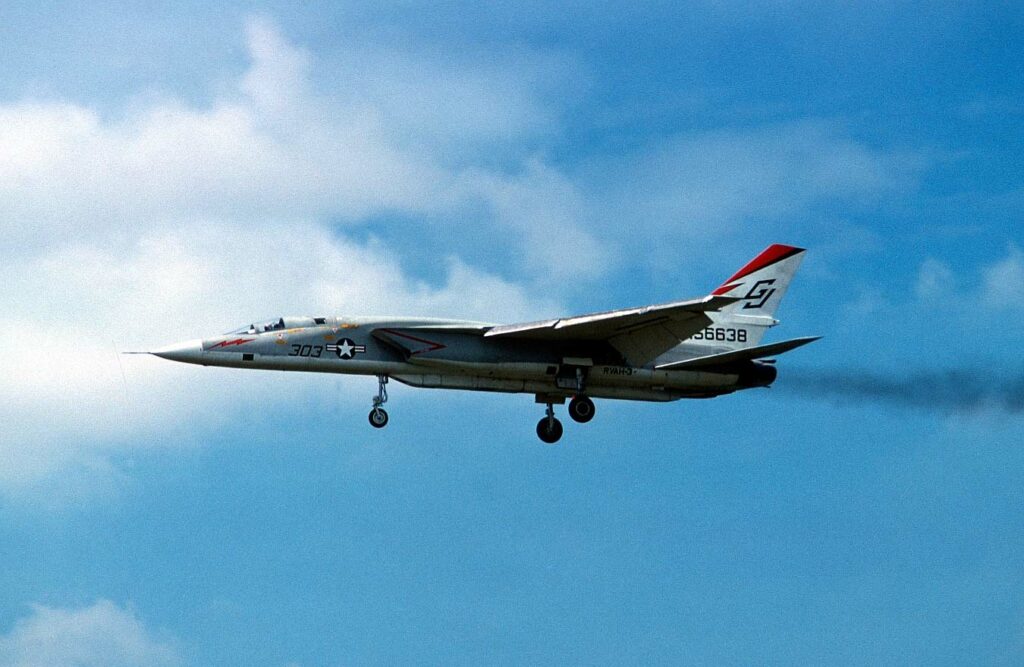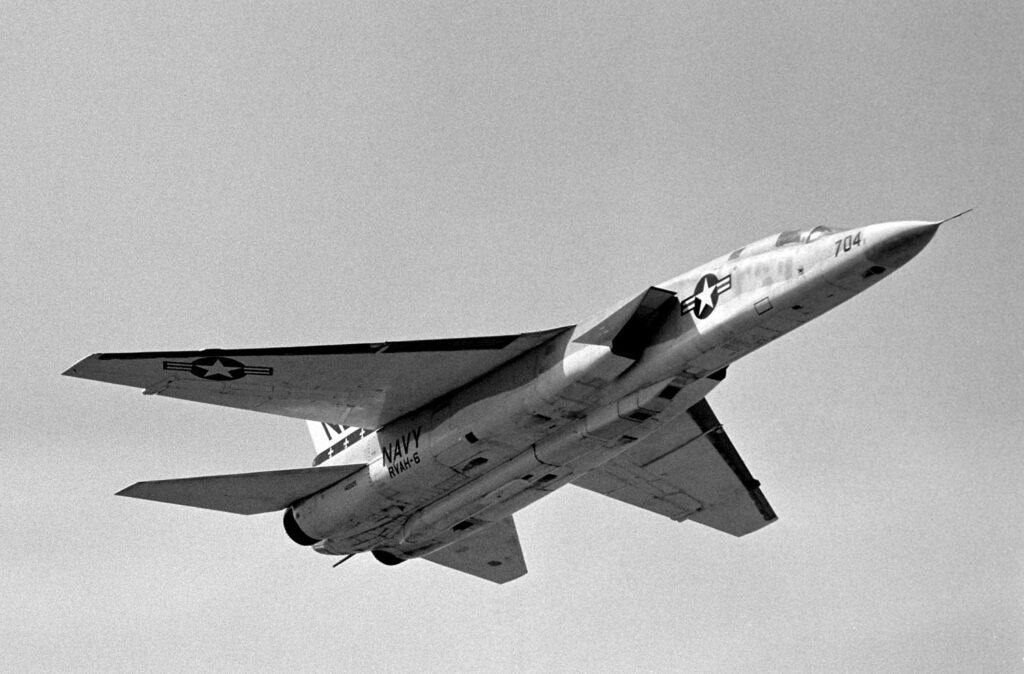High-speed, twin-engine, carrier-based nuclear bomber turned reconnaissance aircraft.
In brief
The North American A-5 Vigilante was an advanced, carrier-based aircraft developed in the late 1950s for the United States Navy. Boasting a sleek design and cutting-edge technology, it was primarily intended as a nuclear bomber but later served as a reconnaissance aircraft. With a length of 76 feet 6 inches, a wingspan of 53 feet, and powered by two General Electric J79-GE-8 turbojets, the Vigilante could reach speeds over Mach 2. Its distinctive features included a tandem two-seat configuration, a sophisticated navigation and bombing system, and an innovative linear bomb bay deployment method. However, its bomber role was short-lived, transitioning to reconnaissance due to strategic shifts in military doctrine.

History of the Development of the North American A-5 Vigilante
The epoch of the 1950s and 1960s was a time of rapid technological advancements and geopolitical tensions, highlighted by the Cold War between the United States and the Soviet Union. In this era, the strategic necessity for a superior nuclear strike capability was paramount. The United States Navy sought a high-speed, high-altitude, carrier-based aircraft capable of delivering nuclear payloads with unprecedented precision and speed, leading to the development of the North American A-5 Vigilante.
Launched by North American Aviation, the A-5 Vigilante program aimed to replace the aging Douglas A-3 Skywarrior. The project was initiated in the mid-1950s, with the first prototype taking to the skies on August 31, 1958. The Vigilante was a product of its time, designed to meet the Navy’s demanding requirements for a bomber that could ensure nuclear deterrence from the sea.
Unlike many of its contemporaries, the A-5 did not receive a NATO nickname, primarily because it was a specific model developed for the U.S. Navy and did not see widespread use with NATO allies. The primary objective of the Vigilante’s development was to deliver a platform capable of high-speed, high-altitude penetration of enemy airspace, ensuring the United States could project power globally, even in the face of sophisticated enemy air defenses.
Design of the North American A-5 Vigilante
The North American A-5 Vigilante was a marvel of engineering, embodying the cutting edge of technology and design principles of its time. It featured a sleek, aerodynamic profile that minimized drag, allowing it to achieve speeds exceeding Mach 2. With a length of 23.32 meters (76 feet 6 inches) and a wingspan of 16.15 meters (53 feet), the Vigilante was built for performance. Its power came from two General Electric J79-GE-8 turbojet engines, each capable of producing 17,000 pounds of thrust with afterburner, propelling the aircraft to high speeds and altitudes.
One of the most distinctive design features of the A-5 was its linear bomb bay, a novel approach that used a tunnel extending from the bomb bay to the rear of the aircraft for bomb deployment, reducing drag and improving high-speed performance. However, this system, while innovative, was not without drawbacks, as it limited the aircraft’s flexibility in weapon deployment.
The Vigilante’s avionics were equally advanced, featuring state-of-the-art navigation and bombing systems that enabled precise targeting in the pre-satellite era. Its reconnaissance variants were equipped with sophisticated sensors and cameras, allowing for detailed surveillance over enemy territory.
The design of the A-5 was both its greatest strength and its Achilles’ heel. While it offered unparalleled speed and performance, its complexity and maintenance demands limited its operational flexibility. Additionally, the focus on speed and altitude came at the expense of maneuverability and load-carrying capacity, compared to some of its contemporaries.
Performance of the North American A-5 Vigilante
The performance of the A-5 Vigilante was exceptional, with capabilities that set it apart from its peers. Powered by two General Electric J79-GE-8 engines, the Vigilante could reach a top speed of over Mach 2 (1,320 mph or 2,124 km/h) and attain a ceiling of over 52,000 feet (15,850 meters). Its range was approximately 1,370 nautical miles (2,537 kilometers), extendable with aerial refueling.
When compared to its contemporaries, such as the Soviet Tu-22 Blinder, the Vigilante boasted superior speed and altitude performance, though it carried a smaller payload. This focus on speed and electronic warfare capabilities made it a formidable platform for reconnaissance missions, where it outperformed many of its competitors.
Variants of the North American A-5 Vigilante
The A-5 Vigilante saw several variants throughout its service life, each tailored to specific roles and capabilities. The initial version, the A-5A, was designed as a nuclear bomber. It was followed by the A-5B, which featured improvements in avionics and weapon systems. The most significant transformation came with the RA-5C variant, a dedicated reconnaissance version equipped with advanced sensors and cameras for intelligence gathering. This variant became the most widely used and is often associated with the Vigilante’s legacy.

Military Use and Combat of the North American A-5 Vigilante
Though initially designed as a nuclear bomber, the A-5 Vigilante’s most notable contributions came in its reconnaissance role, particularly as the RA-5C variant during the Vietnam War. Equipped with a suite of sophisticated sensors and cameras, the RA-5C conducted critical surveillance and target acquisition missions over North Vietnam, providing invaluable intelligence that guided U.S. military operations.
The Vigilante did not engage in traditional bomb-dropping combat missions; instead, its speed and high-altitude capabilities made it an elusive target for enemy defenses, allowing it to gather crucial data with relative impunity. Its performance in Vietnam showcased the strategic value of high-speed reconnaissance aircraft in modern warfare.
Despite its effectiveness, the A-5 Vigilante faced competition from other reconnaissance platforms and was eventually phased out in favor of multi-role aircraft and satellites offering greater versatility and lower operational costs. The last Vigilantes were retired from active service in the 1970s, marking the end of an era for one of the Navy’s most unique and technologically advanced aircraft.
The North American A-5 Vigilante was a product of its time, embodying the technological ambition and strategic priorities of the Cold War era. Its design and performance characteristics reflected the cutting edge of aviation technology, setting standards for speed, altitude, and electronic warfare capabilities. Though its career as a nuclear bomber was brief, its legacy as a reconnaissance aircraft remains significant, highlighting the evolving nature of military aviation and the enduring value of innovation and adaptability in the face of changing strategic landscapes.
Back to the Bombers section.